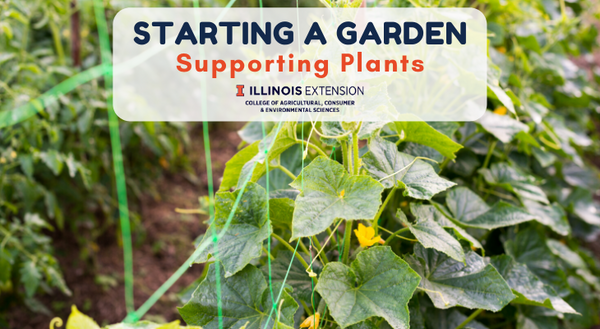
Have you ever tried growing squash, and had the plants completely take over your garden? How about growing tomatoes without a cage? Many of our most popular garden crops such as peas, green beans, cucumbers, tomatoes, and melons grow as vines. They can take up a considerable amount of space in the garden. Providing support to these plants in the form of cages, stakes, and trellises can make growing them easier.
There are a variety of benefits to providing your plants with support.
- The reason most people provide support is that the plants will take up less room. By shifting the plant growth vertically instead of horizontally, it will free up space in your garden for additional plants, or allow you to grow large vining crops in a smaller area.
- Walking through cucurbit crops (squash, pumpkins, cucumbers, watermelons) is like walking through an obstacle course. Vines, leaves, and fruit cover the ground, and it can be challenging to get into plants, while avoiding crushing them, to weed, scout for pests and spray. By growing them up on some sort of support, you can again keep the ground clearer and avoid damaging the plants.
- The quality and appearance of fruit can also be improved. If you’ve grown cucurbits, you’ve probably noticed that the side of the fruit that sits on the ground is often flat and slightly off-colored (ground spots). By growing the plant up, the fruit won’t be resting on the ground, and these blemishes can be avoided, cucumbers will also grow straighter. This works best for smaller fruit (3 pounds or less). If you’re growing plants with larger fruit or melons (they tend to ‘slip’, or fall off of vines when ripe), you may need to make hammocks or slings to support the fruit.
- Harvesting the fruit is also easier when it is up off the ground. No (or less) bending over!
- Growing plants off of the ground can also help with pest and disease management. Plants will be easier to scout, and it can help reduce disease problems. With the plant canopy up off of the ground, there is better airflow through the plants, which allows the canopy to dry out faster, helping to reduce disease development.
Now that we’ve discussed some of the benefits of supporting plants let's look at some of the ways this can be done.
Cages
Cages are most commonly used to support tomatoes. They are readily available at nurseries and garden centers. Most commercially available cages work best for smaller determinate varieties. Indeterminate plants typically grow too large for these cages to adequately support them. Alternatively, you can build your own cages from wood and wire or concrete reinforcing wire. Cages can also be beneficial if you are growing peppers or eggplants. These plants can be brittle, and caging them can help prevent branches from breaking when they are loaded with fruit.
Stakes
A variety of different objects can be used as stakes such as wood, bamboo, t-posts, and rebar to support plants. Stakes are typically 5 to 6 feet tall, and wooden stakes should be at least 1-inch square. Depending on what you’re growing, they may need to be taller. Plants can be grown on a single stake, or several stakes can be tied together to form a tripod or teepee that plants such as peas and pole beans can be trained to grow up. Some plants like peas and pole beans produce tendrils and will attach themselves to stakes. Other plants, such as tomatoes, will need to be tied to them. Another way of staking tomatoes is to use the stake-and-weave/basket weave. This technique is useful if you are growing multiple tomato plants. Stakes are placed in the ground about every six feet, and plants are held in place between twine.
Trellises
Trellises are commonly used to grow vining crops, particularly cucurbits. Trellises typically have two vertical supports (stakes) with some sort of netting, mesh, wood/bamboo, or string suspended in between them. Alternatively, stakes can be placed into the ground at an angle to maximize the amount of sunlight a plant receives. Doing this will also allow the fruit to hang freely underneath the trellis, making them easier to harvest. When building a trellis, the materials you use, their size (diameter), and how deeply you drive your stakes into the ground (at least a foot) will depend largely on what you are trying to grow.
While I’ve focused on vegetable crops, these techniques can also be used to support fruit such as blackberries and raspberries as well as ornamental plants.
Want to get notified when new Good Growing posts are available? SIGN UP HERE!